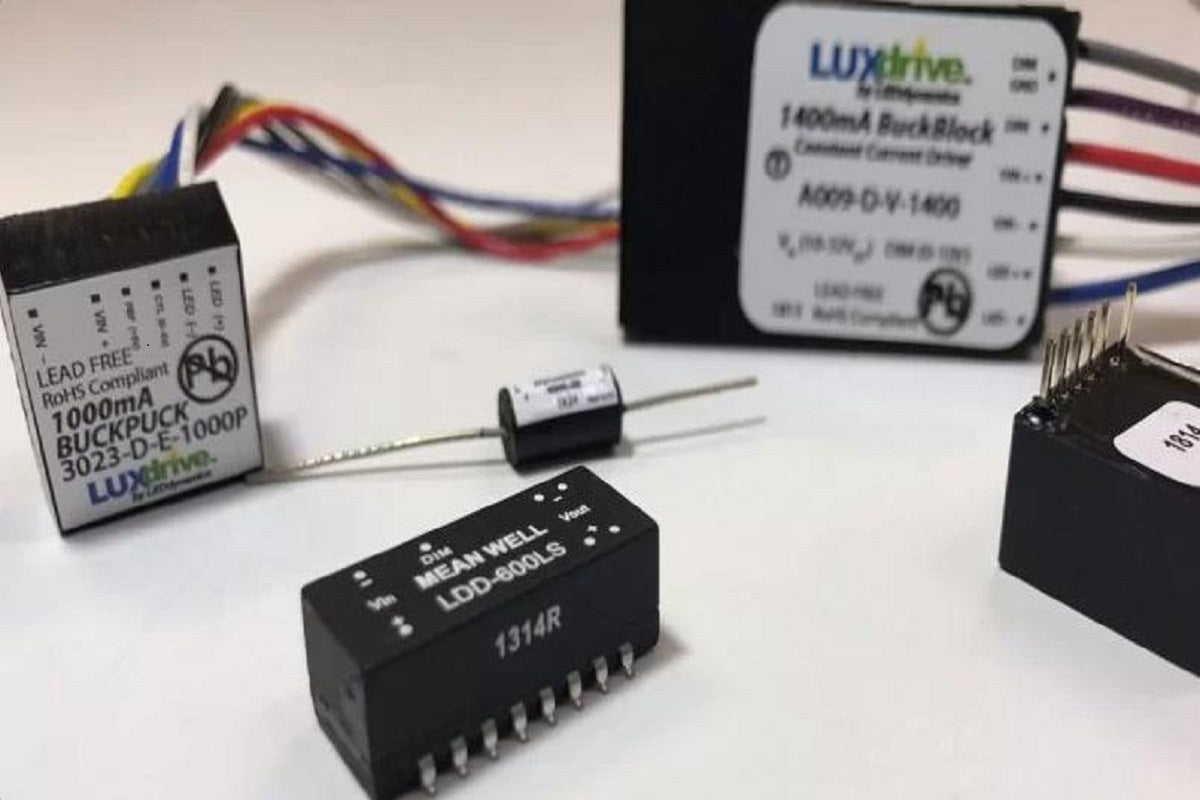Ⅰ Introduction
Light Light-emitting diodes (LEDs) have become widespread in modern lighting, transforming how we brighten our homes, offices, and public spaces. While LEDs are technological marvels, an unsung hero works behind the scenes to ensure their peak performance and longevity: the LED driver. This critical electronic component regulates the power delivered to LEDs, ensures a constant electrical current, and protects LEDs from voltage fluctuations. In this post, we'll delve into the realm of LED drivers, discussing their significance, functionality, types, and critical position in the LED lighting ecosystem.
Choosing the Right LED Driver for an LED Installation
Ⅱ Understanding LED Drivers
2.1 What is an LED Driver?
Light-emitting diodes (LEDs) have become common in modern lighting, changing the way we illuminate our homes, offices, and public spaces. While LEDs are scientific marvels, an unsung hero works behind the scenes to provide optimal performance and longevity: the LED driver. This crucial electronic component regulates the power given to LEDs, maintains a constant electrical current, and protects them from voltage fluctuations. In this post, we'll look into LED drivers, including their relevance, functionality, types, and important role in the LED lighting ecosystem.

2.2 The Importance of LED Drivers
LED drivers are essential for several reasons:
1. Current Regulation: LEDs are current-driven devices, which means that their light output is proportional to the current flowing through them. LED drivers ensure that the current remains constant despite fluctuations in the input voltage.
2. Voltage Protection: LEDs are susceptible to voltage fluctuations. Too much voltage can harm or destroy an LED, but too little voltage can cause poor performance or flickering. LED drivers defend against voltage fluctuations.
3. Efficiency: By supplying appropriate power conditions, LED drivers assist enhance the efficiency of LED lighting systems, ensuring that energy is not wasted and that LEDs function to their full potential.
4. Longevity: Proper current control and voltage spike protection considerably enhance LEDs' longevity, allowing them to operate for tens of thousands of hours.
5. Dimming Capabilities: Many LED drivers provide dimming functionality, which allows customers to customize the light output to their specific needs and tastes.
Ⅲ How LED Drivers Work
LED drivers operate on the principle of power conversion and regulation. Here's a simplified overview of their functionality:
- Input Stage: The driver gets power from the main supply, which can be either alternating current (AC) or direct current.
- Rectification: For an alternating current input, the driver first converts it to direct current.
- Voltage Conversion: The input voltage is then converted to the proper level for the LED or LED array.
- Current Regulation: To maintain a constant current output, the driver uses a variety of strategies (including linear regulation and a switch-mode power supply).
- Protection Circuits: Built-in protection devices prevent overvoltage, overcurrent, and short circuits.
- Output Stage: Regulated power is given to the LED(s) at the appropriate voltage and current levels.
Ⅳ Types of LED Drivers
LED drivers come in various types, each suited for different applications and requirements:
4.1 Constant Current Drivers
These drivers produce a constant current output independent of the voltage across the LED. They are suited for high-powered LEDs and applications requiring continuous brightness.
4.2 Constant Voltage Drivers
Constant voltage drivers provide a fixed voltage output and are commonly used with LED strips or modules that include current-limiting resistors.
4.3 AC LED Drivers
These drivers, which are designed to work directly with alternating current power sources, are commonly used in home and commercial lighting.
4.4 DC LED Drivers
These drivers use DC power sources and are commonly found in low-voltage systems, automotive applications, and battery-powered devices.
4.5 Dimmable LED Drivers
Dimmable drivers allow for variable light output, either using traditional TRIAC dimming or more sophisticated ways such as 0-10V or DALI protocols.
Ⅴ Factors to Consider When Choosing LED Drivers
Selecting the right LED driver is crucial for the performance and longevity of an LED lighting system. Here are some key factors to consider:
- Input Voltage Range: Make sure the driver is compatible with the power supply.
- Output Current and Voltage: Adjust the driver's output to match the requirements of your LED(s).
- Power Rating: The driver should be capable of handling the entire power draw of your LED system.
- Dimming Requirements: If dimming is required, select a driver with appropriate dimming capabilities.
- Environmental Factors: Take into account the operating temperature range and IP rating for outdoor or hazardous situations.
- Efficiency: Choose drivers with high-efficiency ratings to reduce power loss.
- Size and Form Factor: Make sure the driver fits into the available area in your lighting fixture or container.
- Regulatory Compliance: Ensure that the driver meets all applicable safety and electromagnetic compatibility criteria.
Ⅵ The Future of LED Drivers
As LED technology continues to evolve, so too do LED drivers. Some emerging trends and developments include:
- Increased Efficiency: Current research strives to improve the efficiency of LED drivers, minimizing energy waste and heat emission.
- Smart Drivers: The integration of IoT (Internet of Things) technology provides drivers with advanced functions such as wireless control, color adjustment, and data collection for predictive maintenance.
- Miniaturization: As electronic components get smaller and more efficient, LED drivers reduce in size, enabling for more compact lighting solutions.
- Flicker-Free Operation: Advanced driver designs are aimed at reducing imperceptible flicker, which can cause eye strain and headaches in sensitive persons.
- Enhanced Dimming: Advancements in dimming technology provide smoother, more precise regulation of light output across a wider spectrum.
Ⅶ Conclusion
LED drivers are the underappreciated heroes of modern lighting technology. These vital components ensure LEDs perform well, producing consistent, efficient, and long-lasting illumination. LED drivers are critical to LED lighting's widespread adoption and success because they regulate power, defend against voltage fluctuations, and enable sophisticated features such as dimming.
As we continue to push the boundaries of lighting technology in search of more efficient and diverse solutions, LED drivers will stay at the forefront of innovation. Their continued development will open up new opportunities for lighting design, energy efficiency, and smart home integration.
Understanding the significance and performance of LED drivers is critical for anybody working in lighting design, installation, or maintenance. By choosing the appropriate driver for each application, we can ensure that LED lighting systems work optimally, endure longer, and provide the full benefits of this innovative lighting technology.
As we look forward to a future in which energy efficiency and smart technology play an increasingly essential part in our lives, LED drivers will continue to improve, adapt, and open up new lighting possibilities. Their quiet but critical effort guarantees that the brilliant promise of LED technology continues to shine, illuminating our world more efficiently and brightly than ever before.
Ⅷ FAQ
1. How to check if a LED driver is bad?
If you see flickering or irregular lighting in your LED setup, you must quickly identify the underlying problem. Start by measuring the output voltage with a multimeter. If you notice significant changes in this value, the LED driver is not supplying a consistent power supply.
2. How many years do LED drivers last?
LEDs require a steady DC voltage of 12V or 24V, hence LED drivers are needed for all LED systems (excluding those intended for mains voltage management).
3. Can you run LEDs without a driver?
LEDs require a constant DC voltage of 12V or 24V, hence LED drivers are necessary in all LED systems (excluding those designed for mains voltage management).

